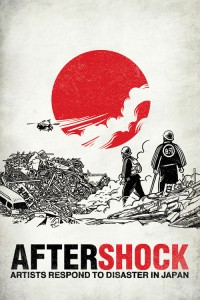JQ Magazine: Book Review – ‘Aftershock: Artists Respond to Disaster in Japan’

“I assumed a response to the earthquake would be grim. I was, however, relieved to see that there is a nice dose of playfulness alongside the serious, an homage to resilience and the inimitable Japanese sense of humor.” (Big Ugly Robot Press)
By Sharona Moskowitz (Fukuoka-ken, 2000-01) for JQ magazine. Sharona works at a literary agency in New York City. She is interested in fresh, new voices in fiction and creative nonfiction.
Composed in the wake of the catastrophic events of 3/11, Aftershock is something of a series of love letters to Japan written in the object of affection’s own familiar dialect: manga. Edited and compiled by American-born and Nagoya-based cartoonist Adam Pasion (Sundogs), the range of over 35 artists/admirers runs the gamut from the seasoned foreign resident to the casual Japanophile, each with an individual style and tone. The pieces are as eclectic as the artists’ experiences and personal ties to Japan, and all proceeds from Aftershock will be donated to relief efforts in northeast Japan.
When I first approached the anthology I wasn’t sure what to expect though I braced myself for gravity. Even in the form of manga, I assumed a response to the earthquake would be grim. I was, however, relieved to see that there is a nice dose of playfulness alongside the serious, an homage to resilience and the inimitable Japanese sense of humor.
For example, “I Was a Teenage Otaku” by JET alum and Tohonharu cartoonist Lars Martinson (Fukuoka-ken, 2003-06) traces the trajectory of the author’s interest in manga and anime, a hobby which “provided the spark that made [him] want to get out there and really explore” and eventually led to his move to Japan as an exchange student. Though his passion for the art form eventually waned, it gave way to a much broader appreciation of the Japanese arts in general.
I particularly enjoyed Alison Wilgus‘s “Japanese House,” which looks at the artist’s first exposure to a traditional Japanese-style house as a child and the effect it had on her. With her evocative, realistic drawings, Wilgus is able to transcend the confines of language and pull the reader into the “starkly subdued” space with her as she tries to pinpoint exactly what she found so moving.
The piece reminded me of my own time in Japan and my oddly sentimental attachment to my traditional Japanese-style flat with its tatami mats, paper sliding doors and deep soaking tub. When I recall my time there, it’s as though the ambiance of the space itself were corporeal: living, breathing, keeping me company, an active character with a distinct personality in my memories.
While many chapters of Aftershock deal with the authors’ reflections about Japan and their own experiences, some such as “Reaction to Disaster” by Sean Michael WIlson and Michiru Morikawa look directly at the disaster, in this case, from the vantage point of a foreign resident living in Kumamoto, Kyushu, far from the epicenter. The author realizes he is probably safe, though he is hit by an emotional wave of his own shock, concern and feelings of helplessness. He is also deluged with phone calls and e-mails from concerned family and friends who have no sense of Japan’s geography and worry that he might be in danger. Like so many who were in Japan during the earthquake but situated at a far remove, the author expresses a familiar sense of restless guilt. He wants to help, yet all he can do is sit in front of the TV like so many staring in disbelief. The author concludes the strip humbly with a frustrated admission, “right now I’m not sure what to think.”
Reading Aftershock is itself an experience. I read the book on my laptop in the calm of my New York living room and I found myself transported to a crowded metro car on the Yamanote Line during rush hour with the book in hand, sandwiched between silent commuters passively taking in the conductor’s monotone keigo train announcements. When I finished, there I was back in my apartment again nowhere remotely near Tokyo, left with a longing for the Japan of both the artists’ minds and my own.
Aftershock is available in paperback and Kindle editions. For Adam Pasion’s Kickstarter video on the project, click here.


Comments are closed.